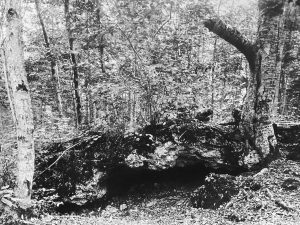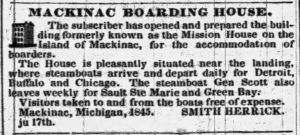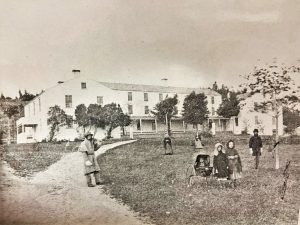

Mackinac Island attracts visitors from around the world to experience interesting history, inspiring natural beauty, and fantastic geological features. For centuries, visitors have stood in awe at famous sites such as Arch Rock, Sugar Loaf, Skull Cave and Devil’s Kitchen. Other features, such as Friendship’s Altar and Cave of the Woods, are reserved for explorers with a trail map and a little determination. Some attractions, including Fairy Arch, Scott’s Cave, and Wishing Spring were well-known to visitors a century ago, but no longer exist today. A few natural wonders never appeared in guidebooks, being mentioned briefly in historical records. One of the most intriguing is the Musical Well of Mackinac Island.
The year 1845 began at the Straits of Mackinac with a mild winter. In early March, many eastern newspapers printed “a letter from a U.S. officer in the garrison at Mackinac.” Dated March 2nd, it announced “the straits are wholly free of ice, east of the island, so that vessels may anchor in the harbor.” Soon, captains of every brig, sloop, schooner, cutter, and steamboat on the Great Lakes made plans to set sail. Newspaper notices called for passengers and announced freight shipments of every description.


Of particular note that spring were advertisements which featured a new “Mackinac Boarding House,” opened by Smith Herrick. In this period, Mackinac Island tourism was still in its infancy. While a small number of visitors found rooms to rent in earlier decades, formal hotels only emerged as the fur trade dwindled in the 1840s. The new establishment was located in the Mission House, a large building near the southeast corner of the island. Built in 1825 by the American Board of Foreign Missions, it operated for 12 years as a boarding school for Native American children before closing in 1837.
During the spring of 1845, Mr. Herrick, along with his wife, Clara, transformed the structure in preparation for guests. Improvements included repairs and paint, carpeting throughout, and “new and excellent furniture – making a most extensive and comfortable house for travellers.” Guests who rented rooms during its first season offered rave reviews of their experiences. Among these testimonials was a letter written at Mission House on June 17th by a correspondent who identified himself as “J.I.M.” Printed in the Boston Statesman on July 5, 1845, he shared the following tale.


“As I was speaking in the evening of my visits to the Sugar Loaf, and ‘Arch Rock,’ Mr Mack Gulpin, a French native, more than sixty years old, and a most excellent, kind hearted man – told me there was a curiosity on the Island not much known; that many years ago, in 1812 – he was gunning with a friend when they came to a hole in a rock. They threw down stones, which appeared to fall very far, and they made very sweet musical sounds as they went down. He had a string about 60 feet long, to which he attached his ramrod and let it down this Musical Well. He vibrated the rod so that it would strike the sides, and he said ‘such sweet and delightful sounds – such beautiful music as came up he never heard in his life.’ He and his companion, he said, staid there nearly all the afternoon enraptured by this music.”
“Mack Gulpin” was surely a member of the McGulpin family. Today, visitors can tour the McGulpin House as part of Historic Downtown buildings on Mackinac Island. William McGulpin, the first known owner, bought the house in 1817 and it stands as one of the oldest remaining homes on the island. The McGulpin family also owned 2 acres of land immediately adjacent to Mission House for many years.
After some encouragement, McGulpin agreed to guide “Jim” to search for the musical well. His account continued, “I furnished myself with twine and irons to draw music from the well. Mack Gulpin led on through the thick woods and along the winding paths, interesting me by the way with his stories of olden times… When he was tired, he would seat himself on the ground – strike fire with his flint and steel – light his pipe and take his rest…


When I was some ways from him, he called me to come; he had found the place. Time, leaves and dirt had choked up its original entrance, so as to divert the descent from a perpendicular, and we could not drop the iron and the line for the music. But the well is there, and is of great depth. I doubt not it descends 160 or 170 feet to the level of the water. Mack Gulpin was disappointed as well as myself at finding we could not get the music. He is sure the well can be restored to its original form and melody with a little labor. If it can be done, Captain Scott, the gallant, active and gentlemanly commander of the garrison, who beautifies, adorns and improves every thing which comes under his care will do it… After carving my name on a poplar tree near the mouth of the musical well, we turned our faces for home.”
The Musical Well was never restored, and memory of its presence has faded away. Today, many island guests still enjoy natural music of Mackinac Island’s north woods. Listen closely, and you can hear songs of warblers in the treetops and aspen leaves fluttering in the breeze. If you stroll down Main Street, past the Mission House, you’ll find the rhythmic clomping of hooves fades to quieter sounds of waves splashing along the shore. Someday, perhaps the Musical Well will naturally reopen, enrapturing fortunate visitors, once again, with delightful sounds in the Mackinac Island forest.








